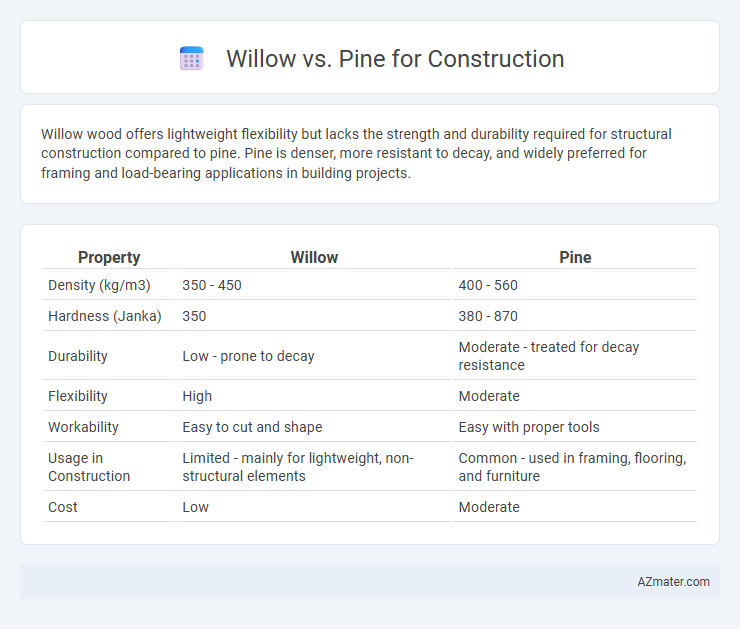Willow wood offers lightweight flexibility but lacks the strength and durability required for structural construction compared to pine. Pine is denser, more resistant to decay, and widely preferred for framing and load-bearing applications in building projects.
Table of Comparison
| Property | Willow | Pine |
|---|---|---|
| Density (kg/m3) | 350 - 450 | 400 - 560 |
| Hardness (Janka) | 350 | 380 - 870 |
| Durability | Low - prone to decay | Moderate - treated for decay resistance |
| Flexibility | High | Moderate |
| Workability | Easy to cut and shape | Easy with proper tools |
| Usage in Construction | Limited - mainly for lightweight, non-structural elements | Common - used in framing, flooring, and furniture |
| Cost | Low | Moderate |
Introduction to Willow and Pine in Construction
Willow wood, known for its lightweight and flexibility, is rarely used in heavy construction but serves well in crafting furniture and woven structures due to its shock-absorbing properties. Pine wood, a softwood with rapid growth and abundant availability, is favored in construction for framing, flooring, and paneling, offering ease of workability and moderate strength. The choice between willow and pine depends on the structural requirements, with pine dominating primary building applications owing to its durability and cost-effectiveness.
Wood Characteristics: Willow vs Pine
Willow wood, characterized by its lightweight and low density, offers excellent shock resistance but lacks the strength and durability required for heavy construction applications. Pine wood is denser and harder with superior structural integrity, making it a preferred choice for framing, flooring, and load-bearing elements. The straight grain and natural resin of pine contribute to its durability and resistance to pests compared to the softer, more porous willow wood.
Strength and Durability Comparison
Pine wood offers superior strength and durability compared to willow, making it a preferred choice in construction for load-bearing applications. Pine's dense grain structure enhances its resistance to impact and wear, while willow's softer, more flexible texture limits its structural capacity and longevity under heavy stress. Builders often select pine for framing and structural components due to its proven performance in maintaining integrity over time.
Workability and Ease of Use
Willow wood offers moderate workability with its lightweight and soft texture, making it easy to cut and shape but less durable for structural applications compared to pine. Pine is a preferred choice in construction due to its strong grain pattern, ease of nailing, and smooth sanding properties, which enhance overall workability on job sites. The natural resin in pine also improves its resistance to wear and simplifies finishing processes, giving it an advantage over willow in terms of ease of use.
Cost and Availability Considerations
Willow wood is generally less expensive than pine due to its rapid growth rate, making it more readily available in specific regions but less common in commercial lumber markets. Pine is widely accessible and preferred in construction for its balance of affordability and structural properties, often resulting in lower overall costs for standard building projects. Cost efficiency depends on local availability; in areas rich in willow, it can be a cost-effective alternative, whereas pine's widespread distribution typically ensures consistent supply and pricing.
Environmental Impact: Sustainability and Sourcing
Willow wood, known for its rapid growth rate and carbon sequestration, offers a more sustainable option compared to pine, which grows slower and requires longer rotation periods. Pine forests, often managed in plantations, can lead to monocultures reducing biodiversity, whereas willow cultivation supports diverse ecosystems and improves soil health. Sourcing willow locally reduces transportation emissions, enhancing its environmental benefits over frequently imported pine used in construction.
Common Construction Applications
Willow wood is primarily used for lightweight, non-structural applications such as crafting furniture, interior paneling, and decorative elements due to its softness and flexibility. Pine, with its higher strength and durability, dominates structural construction roles including framing, flooring, and roofing, as well as exterior applications like decking and fencing. Pine's availability and resistance to warping make it a preferred choice for load-bearing components in residential and commercial buildings.
Resistance to Pests and Decay
Willow wood is generally less resistant to pests and decay compared to pine, making it less ideal for construction in environments prone to insect infestations or moisture. Pine, especially treated varieties like pressure-treated southern yellow pine, offers superior natural resistance to termites, fungi, and rot, enhancing its durability in outdoor and structural applications. Choosing pine for construction ensures greater longevity and reduced maintenance costs due to its enhanced pest and decay resistance.
Aesthetic Differences in Finished Projects
Willow wood offers a light, smooth grain with a pale, creamy color that lends a rustic, natural charm ideal for minimalist or Scandinavian-style interiors. Pine features prominent knots and a warm yellow to reddish hue, creating a cozy, classic look often favored in farmhouse or country-style constructions. The fine texture of willow contrasts with the more pronounced character of pine, influencing the overall aesthetic impact of finished architectural and furniture projects.
Conclusion: Choosing Willow or Pine for Your Build
Willow offers lightweight and flexible wood ideal for decorative or non-structural applications, while pine provides superior strength and durability suited for framing and load-bearing construction. Pine's resistance to warping and availability make it the preferred choice for structural elements and long-lasting builds. Selecting between willow and pine depends on specific project requirements--with pine favored for foundational integrity and willow for aesthetic or lightweight features.

Infographic: Willow vs Pine for Construction
 azmater.com
azmater.com